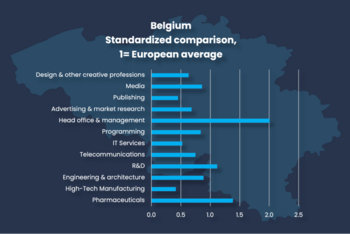
Brussels is the de facto capital of the European Union, the capital of Belgium, the capital of NATO and hosts many international diplomats and UN offices. Yet the share of adults in knowledge intensive regions is lower than in many other European capital regions. Instead, the Brabant Wallon region to the south with a smaller population is amongst the top ten most knowledge intensive in Europe.
While the European Union has no official capital region, Brussels is its de facto capital. This region hosts the European Commission, Council of the European Union, and European Council. Together with Strasbourg in France it is also the seat of the European Parliament. NATO additionally has its headquarters in Brussels, it is a hub for international diplomats and hosts several UN offices.
Due to having so many high-level institutions, Brussels is the seat of many head offices, with 30,000 employed in head office & management. The region also has 18,600 who work in programming, and 11,700 employees in engineering & architecture. In total, 12.5 percent of the adults in Brussels are employed in highly knowledge intensive jobs. This is the finding of the geography of Europe’s brain business jobs index, produced by the European Centre for Entrepreneurship and Policy Reform (ECEPR), with support from Nordic Capital.
Brussels is behind in share of adults employed in highly knowledge-intensive jobs compared to the leading Central European capital regions of Bratislava, Prague, Budapest and Copenhagen where 21.5-24.5 percent of adults are employed in brain business jobs. The Nordic capital regions of Copenhagen and Stockholm have a higher share of engineers and scientists amongst the population but also higher taxes which crowd out private sector activity, they have 19.2-20.8 percents of adults in brain business jobs.
On seventh position in the ranking of 240 European regions ranks the Belgian province of Brabant Wallon, just south of Brussels. Here 19.2 percent of the adults are employed in brain business jobs. Brussels itself is behind the Brabant Wallon region, and also has lower share of brain business jobs compared to some other Western European capital regions such as Dublin (17.8 percent), Berlin (15.9 percent), Amsterdam (15.3 percent), Paris (14.4 percent), and even slightly behind Vienna (12.6 percent).
There are in total 23 regions in Europe which have a higher share of adults in brain business jobs, than the capital region of Brussels.
While Brussels certainly is a knowledge intensive region, it is mainly a region of bureaucracy which does not fully utilize the benefits of being the seat of so much high-level decision making. Instead, the Brabant Wallon region is the seat of knowledge-intensive jobs. In this region the number of adults is one third of that compared to the capital region just north. Yet there are 21,300 jobs combined in pharmaceuticals and in research & development, some 8,400 in head offices & management and 7,700 in programming.
This is a good example of how capital regions, by having high costs, local regulatory bureaucracy that limits growth of housing and commercial properties, can crowd out private business growth to neighboring regions. Brussels seems so focused on international bodies of politics, that it crowd out private sector development.
Brussels in short has a lot of potentials, but needs to aim to become as expert dense as its southern neighbor Brabant Wallon. If it managed to, then Brussels would evolve to Europe’s knowledge intensive capital region. Regulatory and tax reforms in Belgium, as well as regulatory and growth initiatives regionally, are needed for Brussels to realize its potential.
Currently there are few regions of the world that are more important for global politics than Brussels. The next step is to also develop into Europe’s brain business jobs hub, with inspiration from the success of Brabant Wallon to the south.
| Brain Business Jobs per Capita | |
| Brabant Wallon | 19.2% |
| Brussels | 12.5% |
| Vlaams-Brabant | 10.5% |
| Antwerpen | 9.0% |
| Oost-Vlaanderen | 7.1% |
| West-Vlaanderen | 5.5% |
| Limburg (BE) | 5.2% |
| Liège | 3.9% |
| Namur | 3.7% |
| Hainaut | 2.8% |
| Luxembourg (BE) | 1.3% |
Author: Nima Sanandaji, Director European Centre for Entrepreneurship and Policy Reform.
Lead image: chart by the author.












